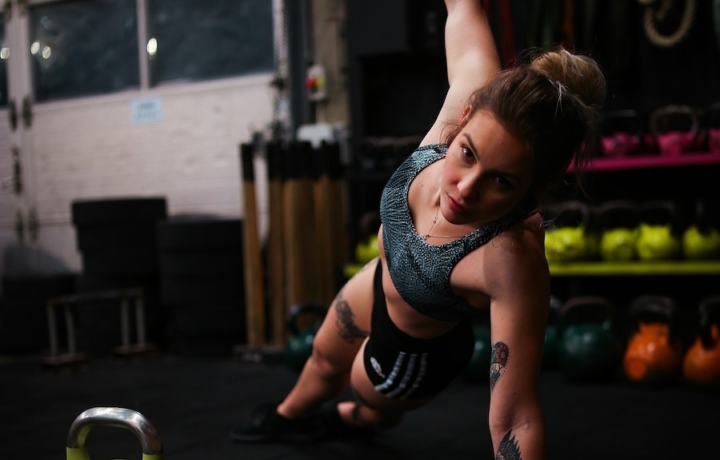Exercise
Shoulder Tap

Shoulder Tap
How to Perform
- Begin in a high plank position with your hands directly under your shoulders, arms straight, and feet hip-width apart.
- Engage your core by drawing your navel toward your spine and squeezing your glutes to maintain a straight line from head to heels.
- Keeping your hips as stable as possible, lift your right hand off the ground and tap your left shoulder while exhaling.
- Return your right hand to the starting position while inhaling, ensuring your wrist aligns under your shoulder.
- Lift your left hand off the ground and tap your right shoulder while exhaling, maintaining a stable hip position.
- Return your left hand to the starting position while inhaling, completing one full repetition.
- Continue alternating shoulder taps at a controlled pace, focusing on minimizing any rotation or shifting in your hips and shoulders.
- Breathe rhythmically throughout the exercise, generally exhaling during the tap and inhaling as you return to the starting position.
Important information
- Keep your hips square to the ground throughout the movement, avoiding the tendency to rotate or pike your hips upward.
- Maintain tension in your core and glutes at all times to prevent your lower back from sagging.
- If the exercise is too challenging, modify by performing it with your knees on the ground instead of your toes.
- Focus on quality over speed, ensuring each shoulder tap is controlled and your body remains stable.

Shoulder Tap
Exercise Details
Primary Muscles
Muscle Groups
Mechanic
Risk Areas
Built for progress
Take the guesswork out of training
Create personalized AI-powered workout plans that evolve with you. Train smarter, track every rep and keep moving forward, one workout at a time.






The Shoulder Tap stands as a deceptively challenging exercise that delivers impressive results for both core stability and shoulder endurance. This intermediate movement primarily targets the front deltoids and abdominal muscles, creating a dynamic tension that forces these muscle groups to work in harmony. As you maintain the plank position throughout the exercise, your core continuously engages to prevent rotation, effectively transforming a simple movement into a comprehensive stability challenge.
What makes the Shoulder Tap particularly versatile is its adaptability across multiple training styles. In HIIT workouts, it serves as an excellent high-intensity interval that rapidly elevates heart rate while building muscular endurance. Crossfit enthusiasts appreciate the functional strength aspects, as the movement mimics real-world stabilization demands. For bodybuilders, Shoulder Taps offer a unique way to enhance mind-muscle connection in the core and shoulders outside traditional isolation work. Even as a warm-up exercise, it effectively activates the central nervous system and primes key muscle groups for more intensive training.
The beauty of this exercise lies in its dual focus on core stability and muscular endurance. Your abdominals, obliques, and lower back work continuously to maintain proper alignment, essentially fighting against rotational forces with each tap. Meanwhile, the anterior deltoids experience time under tension in both supporting and moving phases, building resilient shoulder muscles that transfer to improved performance in pressing movements.
Regular incorporation of Shoulder Taps can significantly improve your ability to maintain core tension during other compound movements like squats and deadlifts. The endurance benefits extend beyond the gym as well, contributing to better posture and reduced risk of lower back pain in daily activities. This exercise reminds us that sometimes the most effective movements aren't about how much weight you can move, but how well you can control your body against gravitational forces.
FAQ - Shoulder Tap
Shoulder Taps primarily target the anterior deltoids (front shoulders) and core muscles including the rectus abdominis, obliques, and transverse abdominis. Your serratus anterior, triceps, and upper back muscles also engage as stabilizers throughout the movement.
The most common mistakes include rotating the hips instead of keeping them square to the floor, sagging in the lower back, and rushing through repetitions. Focus on maintaining a rigid plank position with your shoulders stacked directly over your wrists and hips level throughout the entire exercise.
Beginners can perform Shoulder Taps from a knee plank position instead of a full plank to reduce intensity. Alternatively, try widening your foot stance for better stability or performing the exercise against a wall or elevated surface like a bench to decrease the load on your shoulders and core.
Incorporate Shoulder Taps 2-3 times weekly, either as part of your core training or within full-body circuit workouts. For best results, perform 2-3 sets of 10-20 taps per side, focusing on quality movement rather than speed or volume.
Progress your Shoulder Taps by elevating your feet on a step or stability ball, adding a weight plate on your lower back, increasing time under tension with slower taps, or incorporating shoulder tap variations like spider taps (bringing knee to elbow) between standard taps.









